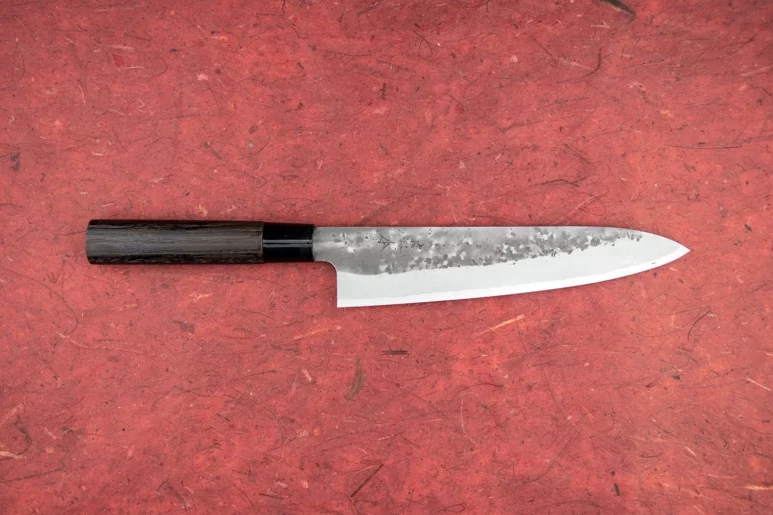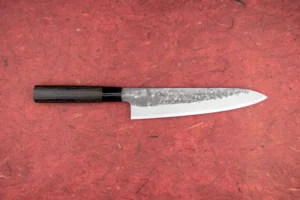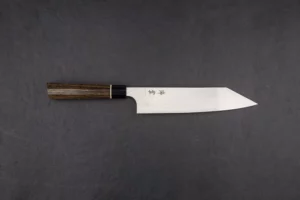Table of Contents
The Gyuto and Kiritsuke are both Japanese multipurpose knives. Whereas the Gyuto is more popular, both the knives have high ratings when it comes to performance.
So, if you are shopping for a busy kitchen knife, which is the best pick. To answer this question, let us look at the individual characteristics of each knife. We shall then identify the strength of each knife and where it’s best applicable.
Gyuto Knife
The Gyuto is best described as the Japanese version of the Western chef’s knife. Gyuto adopts the rounded belly design of the western chef knife. Also, it has a flat spine and pointed tip, giving it a multipurpose edge.
Unlike the western chef’s knife, Gyuto has a signature Wa handle. In addition, the Gyuto has a thinner and sharper blade giving it a superior performance. The Gyuto is a double bevel knife, which means both sides of the blade have razor-sharp edges.
The Kiritsuke Knife
The Kiritsuke is a hybrid of the Usuba and the Yanangiba knives. The combination gives the knife multifunctional capabilities. Kiritsuke has an 8-inch flat profile blade. The knife boasts a reverse tanto tip that gives it a sword-like appearance.
The Kiritsuke knife is single beveled. Thus, only one side of the blade has the angle that forms razor-sharp edges. The knife features the Japanese wooded w- handles, which come in D, oval and octagonal shapes.
Gyuto vs. Kiritsuke
Let’s look at the differences between the Gyuto and Kiritsuke knives. We will base the comparison on both knives’ features and functionalities.
Features
The most notable difference between the Gyuto and Kiritsuke is their shape and design. The Gyuto has a rounded belly and a point that meets towards the middle of the blade. The Kiritsuke features a straight spine, heel, and a reversed tanto point.
Another key notable difference is that the Gyuto knife is a double bevel knife, while the Kirituske is a single beveled. Kirituske maintains the traditional single-bevel style which is favored by most Japanese chefs.
Functionality
Precision cuts (tip work)
The Kiritsuke tango tips perform better tip work than the Gyuto. The angled tip of the Kiritsuke gives the user a better clearance and control of the knife. The shape of the tip also allows you to concentrate on the tip while sharpening it.
Thus, the tip can cut through the more delicate ingredients easily. Because of the flat spine of the knife, you do not have to tilt the knife up while using the tip. The Gyuto is also good with the tip work. But because of the round belly, you must tilt the knife a bit while using the tip.
Rock chopping motion
When you chop the vegetables on the chopping board, you want a knife that provides a firm grip on the board. The heel of the Gyuto knife is flat and provides the firm grip you need for the rock chopping motion. The round curves also chop the vegetables with little movement.
Also, the distance between the heel and the handle gives your fingers enough clearance. Thus, you do not have to worry about hurting your knuckles while tapping the ingredients. As we have seen, the essential part of the blade while rock chopping is the belly. The Kiritsuke has a flat profile and is thus not ideal for the chopping tasks.
Slicing
When making the slices, the Kiritsuke knife performs better than the Gyuto. Since the Kiritsuke has a flat bottom profile, you can use any part of the blade to make clean cuts.
For the Gyuto, the best part of the knife for slicing tasks is the middle of the blade. The Gyuto also produces clean slices if skilled with the knife and knows which part of the blade to use.
Push and pull chopping motion
The Kiritsuke flat profile allows the blade to come into full contact with the board. Thus, it performs better in push cuts motion than the Gyuto knives. But you will also find contemporary Gyuto knives in the market that have a flat profile. Thus, it’s good to point out that the knife in question is the original Gyuto knife.
The versatility of the knives
Now, let’s look at the ease of use of the knives. The Gyuto adopts the duties of the Western chef’s knife, complete with the double bevel. Thus, the knife is friendly for all types of users. Also, the round belly of the knife makes it ideal for users with less knife handling skills.
The design of the Kiritsuke makes it ideal for users with some knife handling skills. Also, the knife is a single bevel and is meant for specific applications such as preparing sushi. Being a single bevel, the Kiritsuke is also hand specific. You will find that most knives in the market favor right-hand users.
Conclusion
When choosing between the Gyuto and Kiritsuke, the deciding factor is the use of the knife. It’s good to note that the Gyuto knife has an upper hand if you have multi-users in mind because of its versatility.






